
May is an excellent time to fertilize cool-season lawns such as tall fescue and Kentucky bluegrass if they will be irrigated throughout the summer. Non-irrigated lawns often go through a period of summer dormancy because of drought and do not need this fertilization.
May is a good time to fertilize because the springtime flush of growth characteristic of these grasses has tapered off, so the fertilizer you apply will be less likely to cause excessive shoot growth than if you fertilized at a full rate in April. Slow-release nitrogen sources are ideal. These nitrogen sources promote controlled growth, which is desirable as the stressful summer weather approaches. Relatively few fertilizers available to the homeowner supply ALL of the nitrogen in the slowly available form. But one such product that is widely available is Milorganite. Other such products available in the retail market include cottonseed meal, alfalfa-based fertilizers, and any other products derived from plants or animals. (Bloodmeal is an exception, and contrary to popular belief, the nitrogen it supplies is quickly available.) These products are all examples of natural organic fertilizers. They typically contain less than 10 percent nitrogen by weight, so compared to most synthetic fertilizers, more product must be applied to get the same amount of nitrogen. Translation: they are more expensive! Apply enough to give the lawn one pound of nitrogen per 1,000 square feet. For example, if the fertilizer is 6 percent nitrogen by weight, you will need to apply almost 17 pounds of fertilizer product per 1,000 square feet.
Summer lawn fertilizers that contain at least a portion of the nitrogen as slow-release are fine to use as well. Be sure to follow label directions. If cost is prohibitive, you can use the less expensive quick-release (i.e., soluble) sources, but split the application into two doses as follows: apply enough to give the lawn 0.5 lb nitrogen per 1,000 square feet in May and again in early June.
Alicia Boor is an Agriculture and Natural Resources agent in the Cottonwood District (which includes Barton and Ellis counties) for K-State Research and Extension. You can contact her by e-mail at aboor@ksu.edu or calling 620-793-1910. K-State Research and Extension is a short name for the Kansas State University Agricultural Experiment Station and Cooperative Extension Service, a program designed to generate and distribute useful knowledge for the well-being of Kansans. Supported by county, state, federal and private funds, the program has county Extension offices, experiment fields, area Extension offices and regional research centers statewide. Its headquarters is on the K-State campus in Manhattan.




